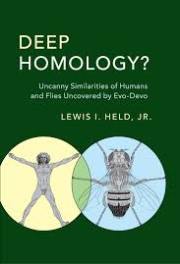Deep Homology? Uncanny Similarities of Humans and Flies Uncovered by Evo-Devo
 Lewis I Held Jr
Lewis I Held Jr
Cambridge University Press, £59.99 (paperback £26.99)
It's over 40 years since I worked in genetics research, so I read this as a lay person not as a specialist and it took a while to get to grips with the jargon. To be fair, the target audience really is the informed reader, but this did not prevent it from being a fascinating read.
Back in my student days, I came across the notion that chordates are upside-down compared with all other bilateria – CNS, gut, and heart reading from dorsal. It turns out that modern genetics lends some support to the idea and the author discusses how the inversion might have happened.
However, in some other respects, flies resemble us. They apparently sleep like we do and for the same reason (but they don't lie down to do it). Their eyes might have a very different structure to ours, but the basic biochemistries are eerily similar. These and a host of other parallels are wonderfully illustrated not only by engaging narrative, but by excellent graphics. For each property being considered, the author presents three columns: a central one where humans and flies are similar, and flanking ones showing 'quirks'. Each diagram is annotated and every aspect explained in detail – where we have the data.
In this last respect I liked the panels that present 'puzzles'. It is refreshing for a science book to highlight what we don't know as well as what we do.
The references occupy almost exactly the same number of pages as the main text, so this is a valuable reference work. That said, it is not a long book, more a monograph, but it is densely packed with information and discussion. I found it surprisingly accessible, despite the state-of-the-art content.
Les Rose CBiol FRSB


